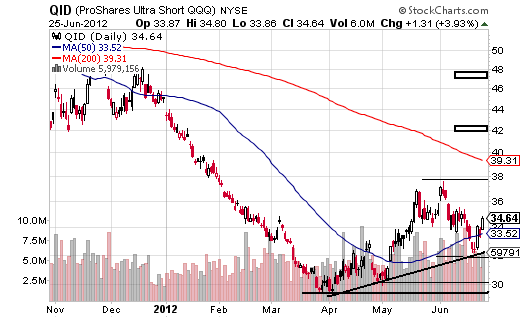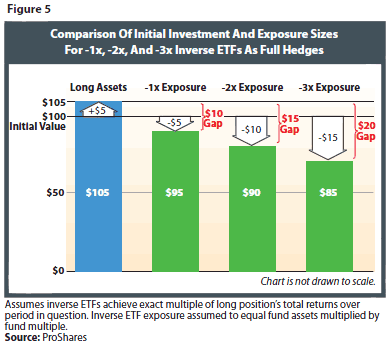How to Use Inverse ETFs for Profit and to Hedge
Post on: 6 Апрель, 2015 No Comment

In the last few years, exchange traded funds (ETFs) have won the hearts and assets of Wall Street players. Currently, more than 670 funds are traded on the U.S. exchanges, valued at more than $650 billion.
Most ETFs are straightforward trading/investing vehicles. For example, if you buy shares of the ETF that tracks the NASDAQ 100 index, the ^ QQQQ^, youre instantly long the shares that represent the stocks in the NASDAQ 100. When you buy the ^XLF^, you own shares in the stock that represents that basket of diversified financial service firms.
Click here to order your copy of The VXX Trend Following Strategy today and be one of the very first traders to utilize these unique strategies. This guidebook will make you a better, more powerful trader.
Now, however, one fund family offers a unique set of ETFs that move inversely to their underlying indexes. In this article, Ill talk about the two types of these popular inverse ETFs and how you can utilize them as 1) pure profit plays, and 2) to hedge your current long positions. Ill also discuss four cautionary points that will add safety to your inverse ETF trades.
When Youre Long the DOG, Youre Short the Dow
The ProShares (www.ProShares.com ) family of ETFs now offers traders and investors inverse ETFs. That means that if you buy shares in one of these ETFs, you are short the correlating index.
For example, say you think the Dow Jones Industrial average is going to slide south. You can buy shares of the ProShares Short Dow30 ^DOG^, which will mean you are actually short the Dow Jones Industrial Average. (When you take a short position, you are betting that financial vehicle will shrink in value.) For every one percent the Dow moves down in value, the DOG moves up one percent. Of course, it goes both ways. If the Dow rises one-percent, the DOG falls one-percent.
Would you like more bang for your buck? Buy shares of the ^DXD^ and for every one-percent the Dow falls, the DXD rises two-percent. Again, it goes both ways. If the Dow rises one-percent, the DXD falls two-percent.
The three charts below represent recent daily charts of the Dow Jones Industrial Average ($DJI), the ProShares Short Dow30 (DOG) and the UltraShort Dow 30 (DXD). Notice our sample trading day, February 5th, which is marked with an arrow. On that day, the Dow Jones Industrial Average opened at 12,632 and closed at 12,264. On the same day, the DOG gapped open about 70-cents at 62.97, and soared to close at 63.70. The DXD gapped up 1.32 higher than the prior days close, to open at 56.30 and close at 57.90. You can see how the UltraShort shares (DXD) traded in a much wider range than the Short shares (DOG). Of course, the advantage of buying the DXD (as compared to the DOG) is that you only need to buy half as many shares to rake in approximately the same gains. The downside? The DXD is much more volatile, and volatility = risk.
Dow Jones Industrial Average
RealTick graphics used with permission of Townsend Analytics, Ltd. 1986-2008 Townsend Analytics, Ltd.
ProShares Short Dow30 (DOG)
RealTick graphics used with permission of Townsend Analytics, Ltd. 1986-2008 Townsend Analytics, Ltd.
ProShares UltraShort Dow30 (DXD)
RealTick graphics used with permission of Townsend Analytics, Ltd. 1986-2008 Townsend Analytics, Ltd.
TWO KEY STRATEGIES
Traders can use ProShares Short and UltraShort ETFs to profit from two key strategies: the first is to trade the funds for pure profit plays; the second is to hedge (protect) core, or long-term portfolio positions.
PURE PROFIT PLAYS
In the old daysbefore the summer of 06 when these nifty trading vehicles began their debutif the market trended lower and you were long you were wrong. Now, however, if you see the major market indices setting up for a cliff fall, you can target one or more of the ProShares Short and UltraShort ETFs to buyand thus end up short that index to capture downside potential. A sampling of ProShares Short funds range from the just-mentioned Short Dow30 (DOG), to the ^ SH^, the ^ PSQ^, ^ MYY^, ^ SBB^, and ^ RWM^. UltraShort versions of those funds are also available.
Do you think growth stocks are ready to stumble? Or, do you believe value stocks are overbought? In addition to the major indices, you can purchase shares in ProShares UltraShort funds that represent either value or growth, thus betting they will fall. Two examples are ^ SJH^, and ^ SKK^.
You can also trade ProShares Ultra Short funds that focus on sectors, such as ^ DUG^, ^ REW^, and everyones favorite shorting vehicle at one time or another in recent months, ^ SRS^.
Now, when traditional ETFs are so easy to sell short, why would anyone bother to buy in order to get short? Answer: you cant sell short in your IRA. With Short and UltraShort ETFs, you are purchasing shares, and purchasing shares doesnt break the rules.
Besides, for a great percentage of traders and investors, selling short goes against their grain. Psychologically speaking, most people are far more comfortable going long then selling short, even if going long really means they are selling short.
When I buy shares of a Short or UltraShort ETF for a pure profit play, I watch the underlying index set-up for a possible move down. Then, if that index does break support or otherwise sets up for a potential move lower, I buy shares of the correlating Short or UltraShort ETF. (I do not use the ETF chart patterns as my primary source of entry signals; in volatile markets, their patterns can become disorderly.)
In the two charts below, you can see how the Russell 2000 Index set up to continue its downtrend the first of this year, and how you could have made a very profitable swing trade from buying the ^ TWM^.
Russell 2000 Index
RealTick graphics used with permission of Townsend Analytics, Ltd. 1986-2008 Townsend Analytics, Ltd.
ProShares UltraShort Russell 2000
RealTick graphics used with permission of Townsend Analytics, Ltd. 1986-2008 Townsend Analytics, Ltd.
On January 2nd, the Russell 2000 (first chart, arrow) opened below its 20-day simple moving average. It fell quickly on the day, continuing a steep slide that started in the last week of December. At the same time, the MACD hooked to the downside right at the zero line, another negative signal.

If you compare this chart to the chart of the ^ TWM^, just below, you can see the opposite signals. The TWM was just bouncing off of its 20-day rising moving average, and the MACD was hooked higher, opposite signals from the Russell 2000 daily chart. Traders could have bought shares of the TWM early in the day (see arrow) and held it for a five-day swing trade. On January 8th (next arrow), as the Russell approached prior support established in July 2006, traders could have closed the TWM trade to pocket about 12 points.
HEDGE YOUR LONG-TERM ACCOUNT POSITIONS
Since the first of this year, many high-flying NASDAQ stocks (think: AAPL, MSFT, GOOG) have paid the Piper, tumbling off huge percentage gains they earned since August 07. Those who held core positions in wobbly tech stocks could have hedged their accounts by buying shares in the ^ PSQ^ or the ^ QID^.
Please note: its downright dangerous to use inverse ETFs in place of responsible money management. If you end up on the wrong side of these ETFs and hold badly losing positions, you can loose a lot of money in a hurry!
A chart of the ProShares Short QQQ (PSQ) is displayed, below. If you compare it to a chart of the NASDAQ 100 over the same period of time, you can see that in January of this year (blue arrow), the PSQ would have served as a valuable hedging tool to protect long-term profits in a tech-heavy portfolio.
ProShares Short QQQ (PSQ)
RealTick graphics used with permission of Townsend Analytics, Ltd. 1986-2008 Townsend Analytics, Ltd.
THREE CAUTION POINTS
Of course, any juicy rewards conceded to us by Mother Market are always accompanied by risk. The following are three points to remember when you trade inverse ETFs.
- First, many stock index ETFs open a few minutes after the market opens and finish pricing a few minutes after the market closes. Thats one reason youll see slightly different price patterns if you compare the actual index to the correlating ETF. A good example of that was displayed in our first chart examples, when the DOG and DXD gapped open to the upside, on the same morning that the Dow plunged (but did not gap down) to the downside. That occurred because traders who saw that the Dow was heading lower at the opening bell, immediately bought shares of the DOG and the DXD. When they opened a few minutes later, this buying imbalance led the ETFs to gap open to the upside. And, that explanation offers a segue to the second point
- While most ETFs are updated to the NAV (net asset value of the shares in the underlying index) every 15 seconds, or so, the fund price, itself, will trade up or down due to demand and supply. That means that in times of extreme demand or supply, the price of the ETF may trade at a premium or discount to its NAV. While this slight imbalance is not of great concern to traders, it can add to an ETFs price volatility.
- When trading inverse (or any) ETFs, please check the volume. As with stocks, funds that trade under 300,000 shares per day usually make poor intraday trading vehicles.
- When youre new to inverse ETFs, limit your position size and holding time to a few days. If you study the charts above, youll notice that these funds tend to move in fits and spurts, according to market volatility. Limited holding periods and firm protective stops will help you accumulate profits with safety.
By the way, if you think overseas markets are due for a pullback, ProShares now offers Short and UltraShort International ETFs. You can check them out on the ProShares website.
You can see why ETFs and certainly inverse ETFs have won the allegiance of Main Street and Wall Street. When used wisely for both pure profit plays and as hedging tools, these versatile funds can add multiple points to your bottom line.
Please sure to check my next column in TradingMarkets.com, when Ill talk about Ultra ProShares (different from inverse ETFs) and how they can boost your upside potential.
Until then, be sure to keep green on your screen and heres to your good wealth!
Toni Turner is a trader and investor with seventeen years of experience in the financial markets. She is the best-selling author of A Beginners Guide to Day Trading Online , 2nd Edition , A Beginners Guide to Short Term Trading and Short-Term Trading in the New Stock Market . Her books have been translated into Vietnamese, Japanese, and Chinese. She is a popular educator and speaks at trading forums and financial conferences across the United States.Toni has appeared on NBC, MSNBC, CNN, and CNBC. She has been interviewed on dozens of radio programs and featured in periodicals such as Fortune magazine, Stocks and Commodities, SFO, MarketWatch.com, Fidelity Active Trader, and Bloomberg Personal Finance.
For more information, please go to www.ToniTurner.com .
Backtested on over 17,000 trades test this new trading indicator for Leveraged ETFs and find high probability setups daily click here now .














